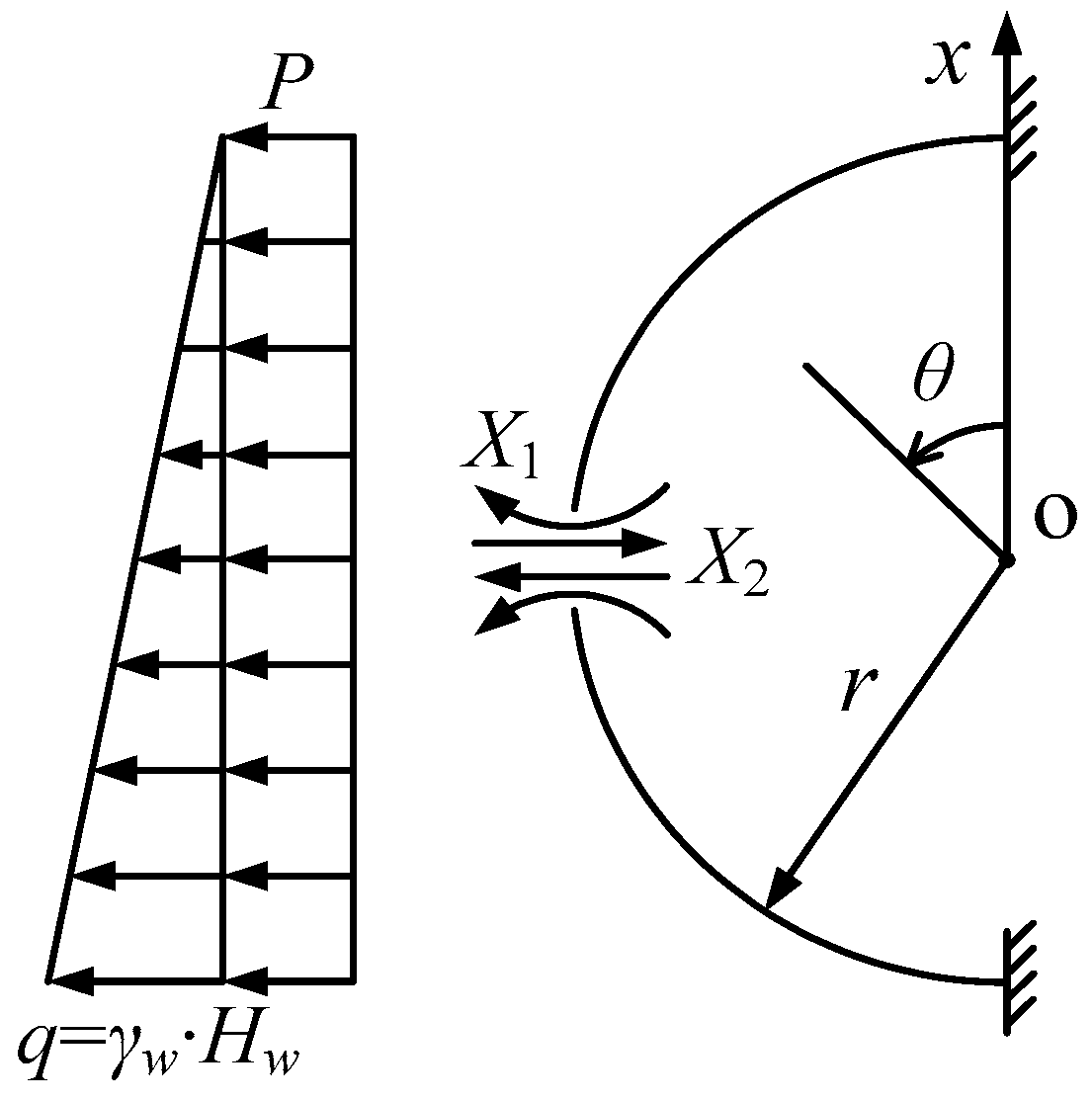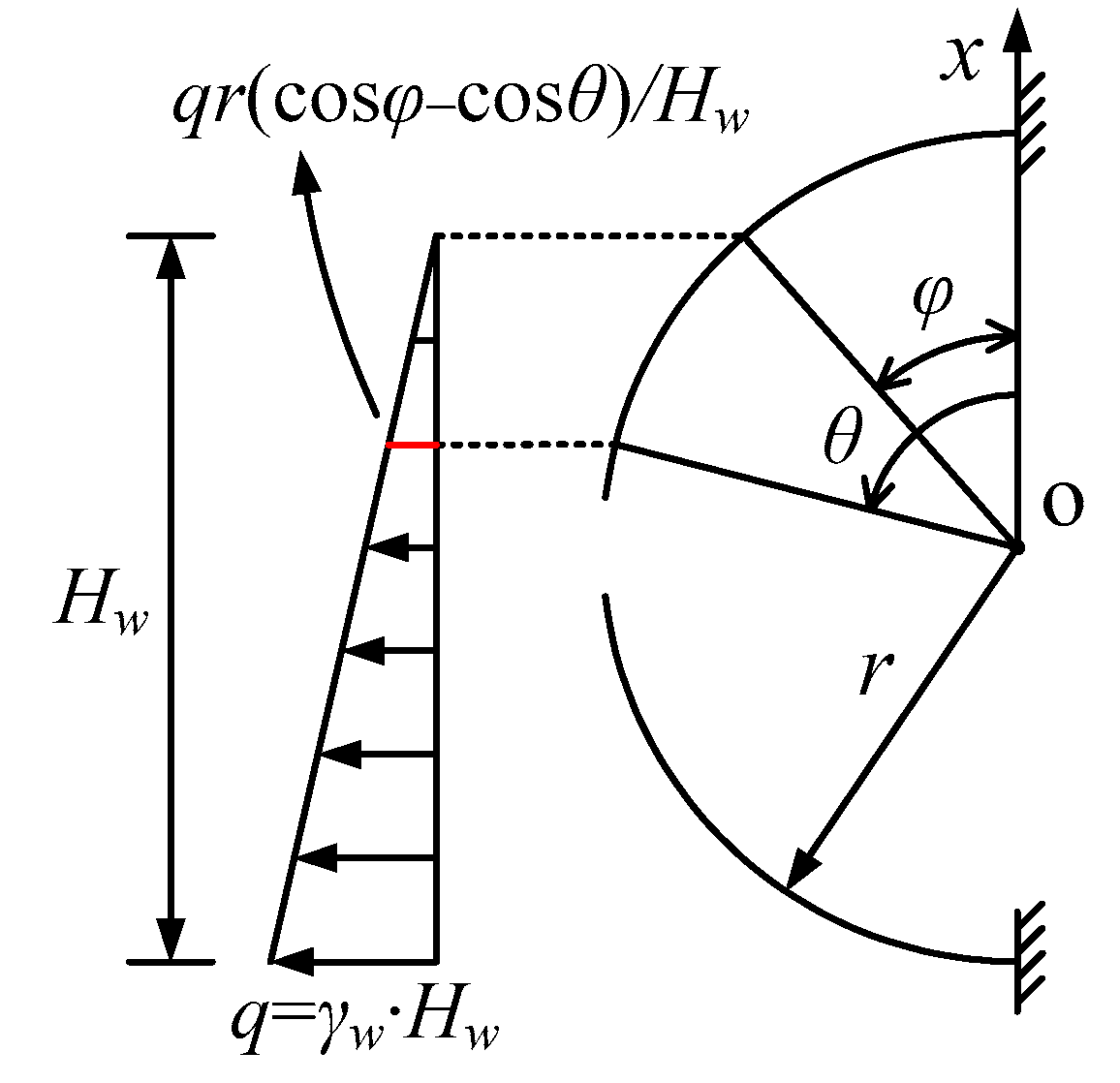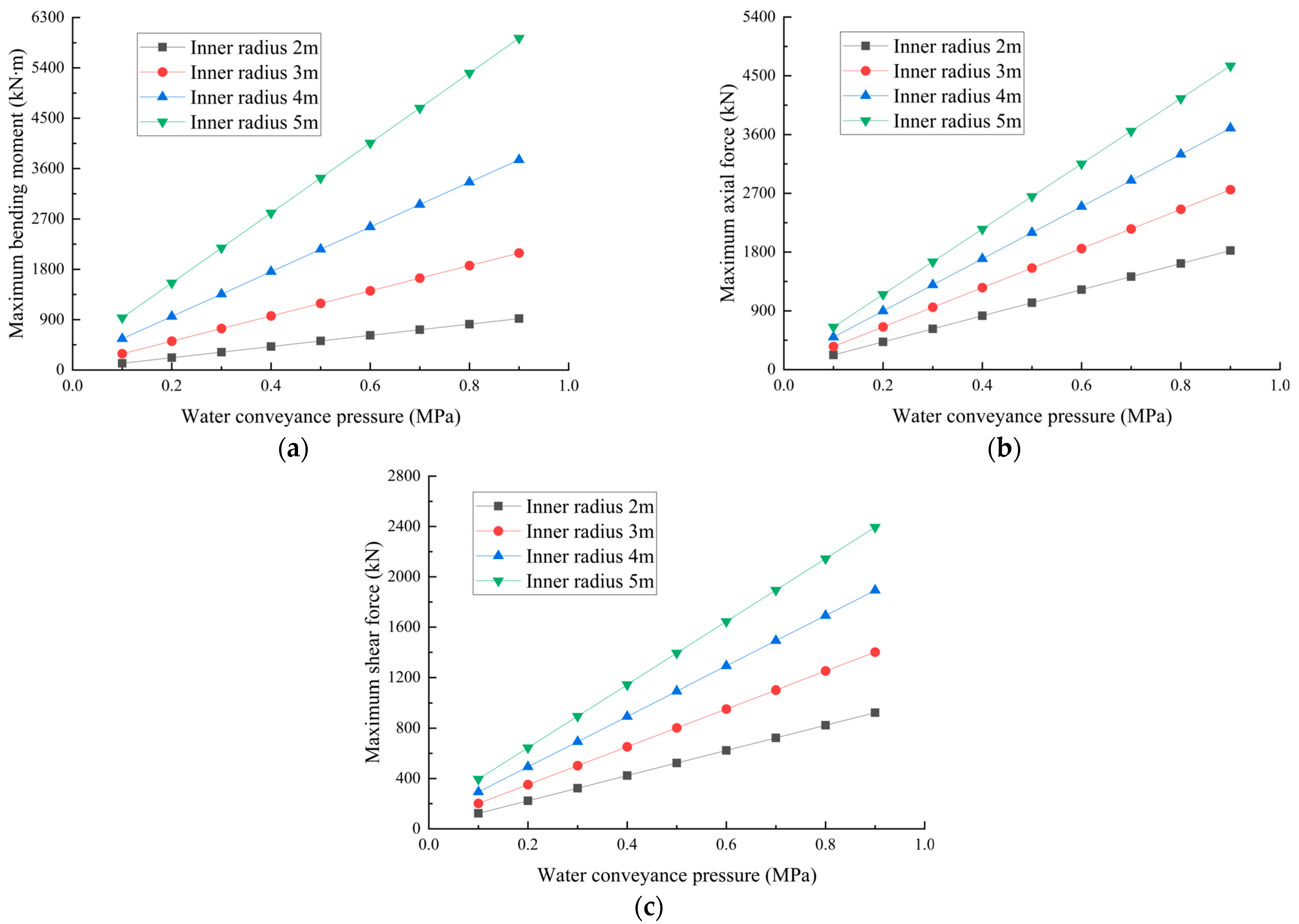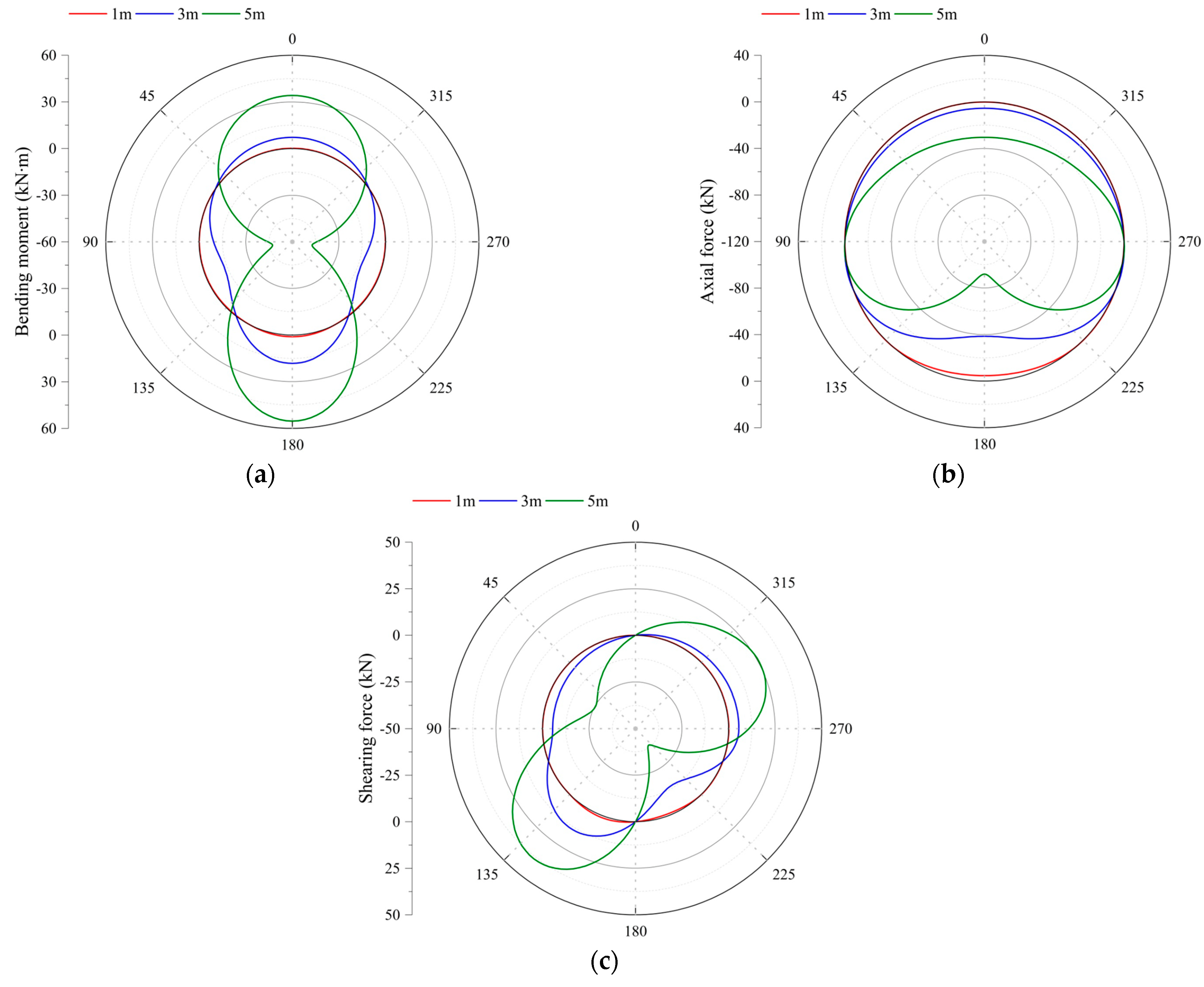Study on the Influence of Internal Water Pressure on the Internal Force of Circular Hydraulic Tunnel Lining
Abstract
:1. Introduction
2. Internal Force Calculation of Lining
2.1. Pressurized Water Conveyance
2.2. Pressureless Water Conveyance
2.2.1. The Water Level Is at the Upper Part of the Tunnel
- (1)
- when 0 ≤ θ ≤ φ,
- (2)
- when φ ≤ θ ≤ π,
- (1)
- when 0 ≤ θ ≤ φ,
- (2)
- when φ ≤ θ ≤ π,
2.2.2. The Water Level Is at the Lower Part of the Tunnel
- (1)
- when 0 ≤ θ ≤ φ,
- (2)
- when φ ≤ θ ≤ π,
- (1)
- when 0 ≤ θ ≤ φ,
- (2)
- when φ ≤ θ ≤ π,
3. Analysis of the Influence of Water Conveyance Pressure on Lining Internal Force
3.1. Influence of Pressurized Water Conveyance Pressure on Lining Internal Force
3.1.1. Influence of Water Conveyance Pressure on the Maximum Internal Force of Lining
3.1.2. Influence of Water Conveyance Pressure on Internal Force Distribution of Lining
3.2. Influence of Pressureless Water Conveyance Level on Lining Internal Force
3.2.1. Influence of Water Conveyance Level on the Maximum Internal Force of Lining
3.2.2. Influence of Water Conveyance Level on Internal Force Distribution of Lining
4. Case Analysis
4.1. Water Conveyance Tunnel of Raw Water Project of Qingcaosha Water Source Area
4.2. Yangqu Hydropower Station Flood Discharge Tunnel
5. Conclusions
- (1)
- The hydraulic tunnel is greatly affected by the internal water pressure. This paper introduces the theory of structural mechanics, considers the operating conditions of different water levels and water conveyance pressures and derives a general formula for calculating the internal force of the lining structure. This calculation method can effectively calculate the value and distribution of internal forces. Based on the modified routine method, the calculation theory of tunnel structure is further improved, which provides a theoretical basis for the design and safe operation of hydraulic tunnels.
- (2)
- When water is delivered under pressure, the maximum internal force of the lining increases with the increase of water conveyance pressure and inner radius. When water is delivered without pressure, the maximum bending moment and axial force of the lining will inverse the increasing trend at the special water level. In addition, the maximum value of lining internal force of pressureless water conveyance is much smaller than that of pressurized water conveyance. Therefore, when the hydraulic tunnel has high requirements for water-passing capacity, it can strengthen the structural strength to carry out pressurized water conveyance or adopt the design scheme of increasing size and the carrying out of pressureless water conveyance.
- (3)
- When water is delivered under pressure, the distribution of lining internal force changes regularly with the increase of water conveyance pressure. The maximum value of internal force is in the fixed special position. When water is delivered without pressure, with the increase in water conveyance level the internal force value of the lining increases continuously and the difference in internal force value at different angles is more significant. The internal force of the lining is much stronger when water is delivered under pressure than when water is delivered without pressure, so the strength of the lining structure should be designed to be larger.
- (4)
- The calculation model ignores both the influence of internal water pressure in the vertical direction and the dynamic characteristics, which is inconsistent with the actual situation. In addition, the mechanism of abnormal maximum bending moment and axial force at special water levels is unclear. These problems need further study.
Author Contributions
Funding
Institutional Review Board Statement
Informed Consent Statement
Data Availability Statement
Conflicts of Interest
References
- Andjelkovic, V.; Lazarevic, Z.; Nedovic, V.; Stojanovic, Z. Application of the pressure grouting in the hydraulic tunnels. Tunn. Undergr. Sp. Tech. 2013, 37, 165–179. [Google Scholar] [CrossRef]
- Rasouli, M. Engineering geological studies of the diversion tunnel, focusing on stabilization analysis and support design, Iran. Eng. Geol. 2009, 108, 208–224. [Google Scholar] [CrossRef]
- Zeng, K.; Xu, J. Unified semi-analytical solution for elastic-plastic stress of deep circular hydraulic tunnel with support yielding. J. Cent. South Univ. 2013, 20, 1742–1749. [Google Scholar] [CrossRef]
- Zhou, Y.; Su, K.; Wu, H. Hydro-mechanical interaction analysis of high pressure hydraulic tunnel. Tunn. Undergr. Sp. Tech. 2015, 47, 28–34. [Google Scholar] [CrossRef]
- Ahmad, S.; Naji, A.M.; Hussain, I.; Rehman, H.; Yoo, H. Ground saturation response during first filling of lined pressure tunnels: A case study. Rock Mech. Rock Eng. 2021, 54, 513–535. [Google Scholar] [CrossRef]
- Rehman, H.; Naji, A.M.; Nam, K.; Ahmad, S.; Muhammad, K.; Yoo, H.K. Impact of construction method and ground composition on headrace tunnel stability in the Neelum–Jhelum hydroelectric project: A case study review from pakistan. Appl. Sci. 2021, 11, 1655. [Google Scholar] [CrossRef]
- Do, N.A.; Dias, D.; Oreste, P.P.; Djeran-Maigre, I. Internal forces in segmental tunnel linings—A comparison between current design methods. J. Min. Sci. 2014, 50, 326–334. [Google Scholar] [CrossRef]
- Huang, Q.F.; Yuan, D.J.; Wang, M.S. Study on the influence of water level on the internal force of shield tunnel segment structure. J. Geotech. Eng. 2008, 30, 1112–1120. (In Chinese) [Google Scholar]
- Dong, L.; Yang, Z.; Wang, Z.; Ding, Y.; Qi, W. Study on internal force of tunnel segment by considering the influence of joints. Adv. Mater. Sci. Eng. 2020, 2020, 1020732. [Google Scholar] [CrossRef]
- Wang, J.; Huang, W.; Xu, R.; Yang, Z.; Xu, R. Analytical approach for circular-jointed shield tunnel lining based on the state space method. Int. J. Numer. Anal. Met. 2020, 44, 575–595. [Google Scholar] [CrossRef]
- Liu, M.; Liao, S.; Xu, J.; Men, Y. Analytical solutions and in-situ measurements on the internal forces of segmental lining produced in the assembling process. Transp. Geotech. 2021, 27, 100478. [Google Scholar] [CrossRef]
- Gurocak, Z. Analyses of stability and support design for a diversion tunnel at the Kapikaya dam site, Turkey. B. Eng. Geol. Environ. 2010, 70, 41–52. [Google Scholar] [CrossRef]
- Gurocak, Z.; Solanki, P.; Zaman, M.M. Empirical and numerical analyses of support requirements for a diversion tunnel at the Boztepe dam site, eastern Turkey. Eng. Geol. 2007, 91, 194–208. [Google Scholar] [CrossRef]
- Takano, Y.H. Guidelines for the Design of Shield Tunnel Lining. Tunn. Undergr. Sp. Tech. 2000, 15, 303–331. [Google Scholar] [CrossRef]
- Carranza-Torres, C.; Diederichs, M. Mechanical analysis of circular liners with particular reference to composite supports. For example, liners consisting of shotcrete and steel sets. Tunn. Undergr. Sp. Tech. 2009, 24, 506–532. [Google Scholar] [CrossRef]
- Huang, X.; Zhu, Y.; Zhang, Z.; Zhu, Y.; Wang, S.; Zhuang, Q. Mechanical behaviour of segmental lining of a sub-rectangular shield tunnel under self-weight. Tunn. Undergr. Sp. Tech. 2018, 74, 131–144. [Google Scholar] [CrossRef]
- Gu, S.; Sun, G.; Su, P. Computational model of outer circle and inner ellipse shield tunnel lining structure. Adv. Civ. Eng. 2021, 2021, 2303140. [Google Scholar] [CrossRef]
- Zhao, C.; Alimardani Lavasan, A.; Barciaga, T.; Kämper, C.; Mark, P.; Schanz, T. Prediction of tunnel lining forces and deformations using analytical and numerical solutions. Tunn. Undergr. Sp. Tech. 2017, 64, 164–176. [Google Scholar] [CrossRef]
- Hu, X.; Zhang, Z.; Teng, L. An analytical method for internal forces in DOT shield-driven tunnel. Tunn. Undergr. Sp. Tech. 2009, 24, 675–688. [Google Scholar] [CrossRef]
- Jiang, H.; Zhou, S.; Di, H.; Ye, W.; Liu, Z.; Zhao, Y. Earth Pressure and Internal Forces of Tunnel Lining in Jet Grouting Reinforced Mud Stratum. KSCE J. Civ. Eng. 2021, 25, 4005–4017. [Google Scholar] [CrossRef]
- Bilotta, E.; Russo, G. Internal Forces Arising in the Segmental Lining of an Earth Pressure Balance-Bored Tunnel. J. Geotech. Geoenviron. 2013, 139, 1765–1780. [Google Scholar] [CrossRef]
- Wang, X.; Behbahani, S.S.; Iseley, T.; Azimi, M.; Wei, X.; Wei, G.; Shi, Y. Vertical tunneling in China-A case study of a hydraulic tunnel in Beihai. Tunn. Undergr. Sp. Tech. 2021, 107, 103650. [Google Scholar] [CrossRef]
- Zheng, X.Y.; Shen, J. Research on Life Cycle Monitoring of Long Distance Diversion Tunnel Based on NFC Context-Awareness. Geotech. Geol. Eng. 2015, 33, 947–958. [Google Scholar] [CrossRef]
- Zhu, Y.; Liu, C. Study on Parameter Influence of New Composite Lining of Water Conveyance Tunnel Under High Internal Water Pressure. Front. Earth Sc Switz. 2022, 10, 920230. [Google Scholar] [CrossRef]
- Zhu, Y.; Liu, C.; Yin, X.; Zhang, J. Analysis of the Internal Force and Deformation Characteristics of Double-Layer Lining Structure of Water Conveyance Tunnel. Geofluids 2022, 2022, 9159632. [Google Scholar] [CrossRef]
- Yan, Z.G.; Peng, Y.C.; Ding, W.Q.; Zhu, H.H.; Huang, F. Experimental study on single-layer lining segment joint load of water conveyance tunnel in Qingcaosha water source source project. J. Geotech. Eng. 2011, 33, 1385–1390. (In Chinese) [Google Scholar]
- Yu, H.; Yuan, Y.; Bobet, A. Seismic analysis of long tunnels: A review of simplified and unified methods. Undergr. Space 2017, 2, 73–87. [Google Scholar] [CrossRef]
- Wang, T.; Wu, H.; Li, Y.; Gui, H.; Zhou, Y.; Chen, M.; Zhao, X. Stability analysis of the slope around flood discharge tunnel under inner water exosmosis at Yangqu hydropower station. Comput. Geotech. 2013, 51, 1–11. [Google Scholar] [CrossRef]
- Ren, X.P. Finite Element Analysis of Surrounding Rock Stability of Yangqu Hydropower Station. J. Water Resour. Water Eng. 2014, 25, 211–214, 218. (In Chinese) [Google Scholar]










| Maximum Internal Force | Pressureless Water Conveyance Level | Pressurized Water Conveyance Pressure | ||
|---|---|---|---|---|
| Half Water Level | Full Water Level | 0.2 MPa | 0.4 MPa | |
| Bending moment (kN∙m) | 16.8 | 62.8 | 487.6 | 913.8 |
| Axial force (kN) | 36.6 | 52.2 | 636.2 | 1220.2 |
| shearing force (kN) | 13.2 | 50.2 | 341.4 | 633.3 |
| Maximum Internal Force | Pressureless Water Conveyance Level | Pressurized Water Conveyance Pressure | ||
|---|---|---|---|---|
| Half Water Level | Full Water Level | 0.2 MPa | 0.4 MPa | |
| Bending moment (kN∙m) | 100.4 | 376.0 | 1771.6 | 3175.1 |
| Axial force (kN) | 120.8 | 172.0 | 1231.7 | 2291.7 |
| shearing force (kN) | 43.5 | 165.5 | 693.0 | 1222.6 |
Publisher’s Note: MDPI stays neutral with regard to jurisdictional claims in published maps and institutional affiliations. |
© 2022 by the authors. Licensee MDPI, Basel, Switzerland. This article is an open access article distributed under the terms and conditions of the Creative Commons Attribution (CC BY) license (https://creativecommons.org/licenses/by/4.0/).
Share and Cite
Zhu, Y.; Liu, C. Study on the Influence of Internal Water Pressure on the Internal Force of Circular Hydraulic Tunnel Lining. Appl. Sci. 2022, 12, 11271. https://doi.org/10.3390/app122111271
Zhu Y, Liu C. Study on the Influence of Internal Water Pressure on the Internal Force of Circular Hydraulic Tunnel Lining. Applied Sciences. 2022; 12(21):11271. https://doi.org/10.3390/app122111271
Chicago/Turabian StyleZhu, Yueyue, and Cheng Liu. 2022. "Study on the Influence of Internal Water Pressure on the Internal Force of Circular Hydraulic Tunnel Lining" Applied Sciences 12, no. 21: 11271. https://doi.org/10.3390/app122111271





